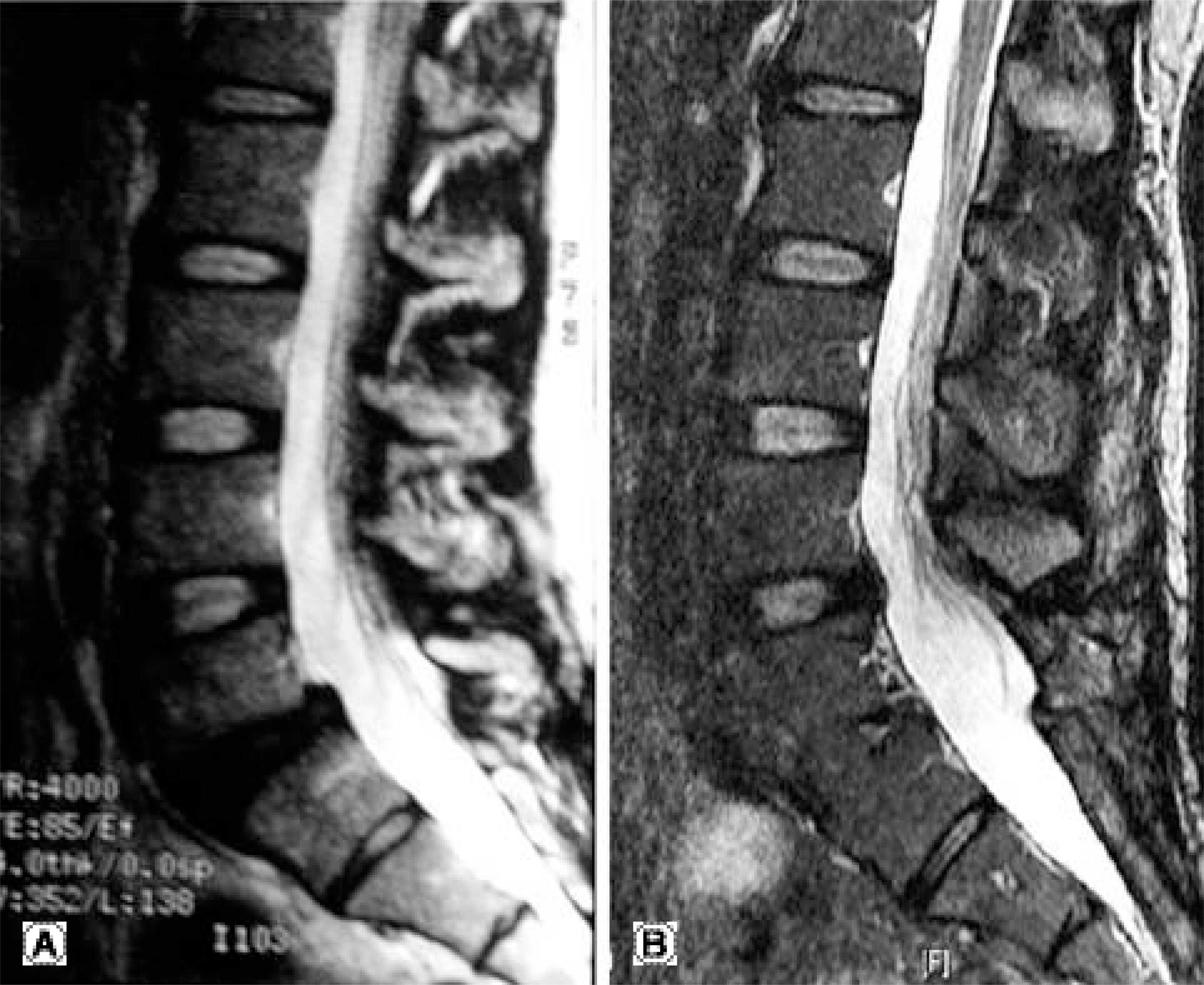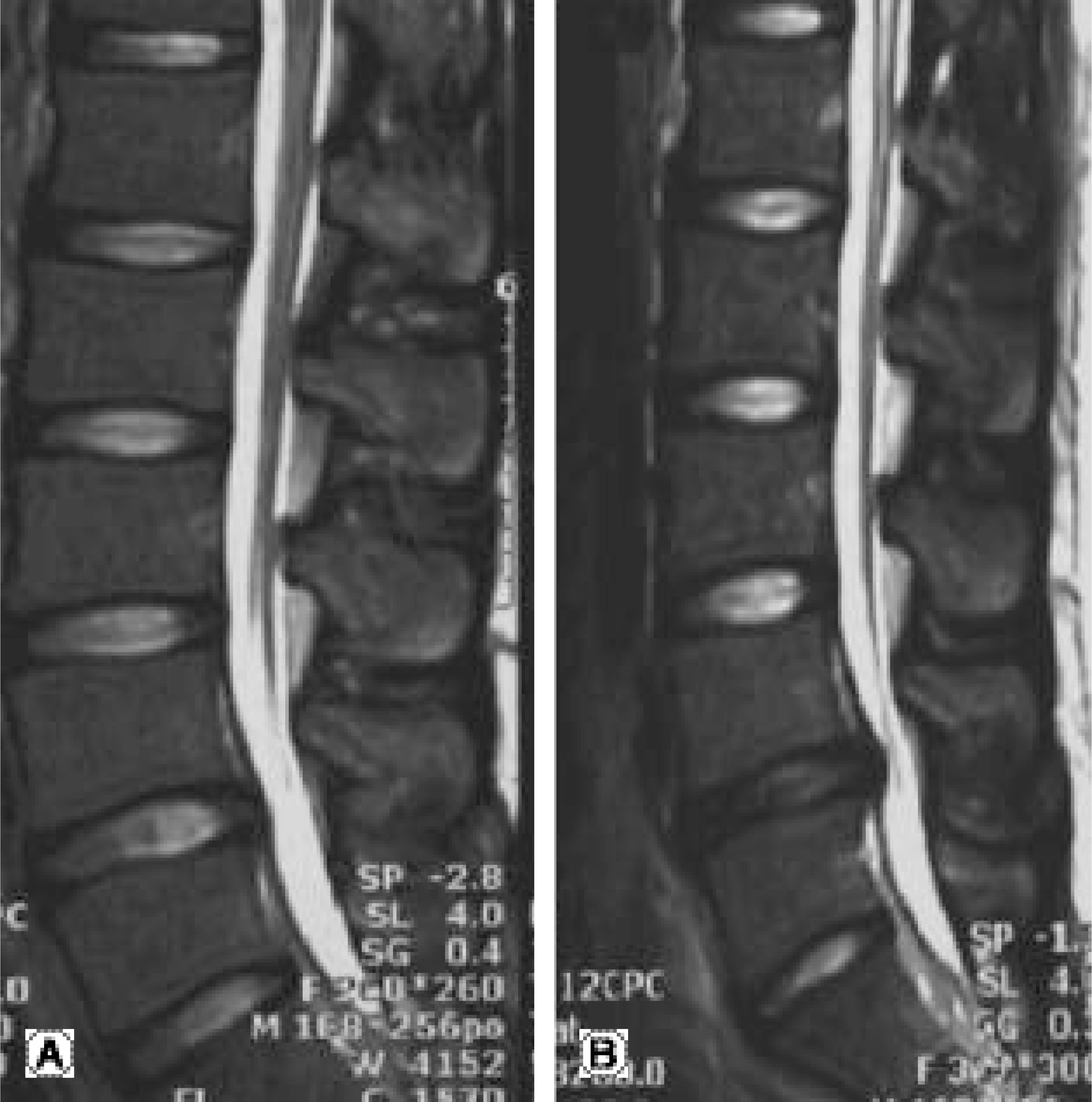J Korean Soc Spine Surg.
2004 Dec;11(4):238-245.
Adjacent Segment Degeneration After Spinal Fusion In Lumbar Degenerative Disorders
- Affiliations
-
- 1Department of Orthopaedic Surgery, Ajou University School of Medicine, Korea. bone@ajou.ac.kr
- 2Department of Orthopaedic Surgery, Konyang University School of Medicine, Korea.
- 3Department of Orthopaedic Surgery, Seoul Adventist Hospital, Korea.
Abstract
- STUDY DESIGN: A retrospective radiological assessment was conducted.
OBJECTIVES
An attempt to analyze the degenerative change of an intervertebral disc for adjacent segment degeneration in lumbar degenerative diseases. LITERATURE REVIEW SUMMARY: A review of the literature failed to uncover any documented study examining the quantitative analysis of the degenerative change of the intervertebral disc for adjacent segment degeneration.
METHODS
This study was based on 45 patients, treated operatively or conservatively at this hospital, between April 1995 and July 2004. 39 and 6 cases of operative and conservative treatments, respectively, were performed. In the 39 operative treatments, there were 34 cases of fusion and 5 of discectomy. Dynamic X-ray and MRI were performed at the initial evaluation, and again more than 2 years later. In the 34 fusion cases, the upper and lower adjacent segments of the fused level were studied, and in the 11 non-fusion cases (conservative treatment or discectomy), the L3-4, L4-5 and L5-S1 level were studied. The instability of the dynamic X-ray and Thompson grade changes of the disc on MRI were also evaluated. Statistical analysis was carried out using the Wilcoxon signed rank test.
RESULTS
Adjacent segment degeneration was found in 10 of the 34 cases (29.4%) on plain X-ray. The average Thompson grades of the 33 upper segment cases were 2.6 and 3.4 preoperatively and postoperatively (P=0.000), and for the 24 of the lower segment cases were 2.9and 3.2 (P=0.033), respectively. No statistical increase in the Thompson grade was found in the non-fusion group.
CONCLUSIONS
The adjacent discs of the fusion group showed statistically meaningful degeneration on MRI, but this was not correlated with adjacent segment degeneration on plain X-ray. Various anatomical and functional factors must be considered in the evaluation of adjacent segment disease.
MeSH Terms
Figure
Reference
-
1). Hambly MF, Wiltse LL, Raghavan N, Schneiderman G. The transition zone above a lumbosacral fusion. Spine. 1998; 23(16):1785–1792.
Article2). Aota Y, Kumano K, Hirabayashi S. Postfusion instability at the adjacent segments after rigid pedicle screw fixation for degenerative lumbar spinal disorders. J spinal disord. 1995; 8(6):464–473.
Article3). Lehmann TR, Spratt KF, Tozzi JE, et al. Long-term follow-up of lower lumbar fusion patients. Spine. 1987; 12:97–104.
Article4). Penta M, Sandhu A, Fraser RD. Magnetic resonance imaging assessment of disc degeneration 10 years after anterior lumbar interbody fusion. Spine. 1995; 20:743–747.
Article5). Shahin E, David WC. Risk factors for adjacent segment failure following lumbar fixation with rigid instrumentation for degenerative instability. J Neurosurg. 1999; 90:163–169.6). Rahm MD, Hall BB. Adjacent segment degeneration after lumbar fusion with instrumentation: A retrospective study. J spinal disord. 1996; 9(5):392–400.7). Brodsky AE. Post-laminectomy and post-fusion stenosis on the lumbar spine. Clin Orthop. 1976; 115:130–139.8). Kumar MN, Baklanov A, Chopin D. C o r r e l a t i o n between sagittal plane changes and adjacent segment degeneration following lumbar spine fusion. Eur Spine J. 2001; 10:314–319.9). Nagata A, Schendel MJ, Transfeldt EE, et al. The effects of immobilization of long segments of the spine on the adjacent and distal facet force and lumbosacral motion. Spine. 1993; 18:2471–2479.
Article10). Wimmer C, Gluch H, Krismer M, et al. AP-translation in the proximal disc adjacent to lumbar spine fusion: a retrospective comparison of mono- and polysegemental fusion in 120 pateients. Acta Orthop Scand. 1997; 68:269–272.11). Wiltse LL, Radecki SE, Biel HM, et al. Comparative study of the incidence and severity of degenerative change in the transition zones after instrumented versus noninstrumented fusions of the lumbar spine. J Spinal Disord. 1999; 12:27–33.
Article12). Frymoyer JW, Hanley E, Howe J, Kuhlmann D, Matteri R. Disc excision and spine fusion in the management of lumbar disc disease: A minimum ten-year follow-up. Spine. 1978; 3:1–6.13). Dekutoski MB, Schendel M, Ogilvie JW, OLsewski JM, Wallace LJ, Lewis JL. Comparison of in vivo and in vitro adjacent segment motion after lumbar fusion. Spine. 1994; 19:1745–1751.
Article14). Guyer RD, Ohnmeiss DD. Intervertebral disc prostheses. Spine. 2003; 28(15S):S15–S23.
Article15). Chung JY, Seo HY, Jung JW. Surgical treatment of adjacent degenerative segment after lumbar fusion-pre -liminary report. J Kor Spine Surg. 2000; 7(2):264–270.16). Ha KY, Kim YH, Kang KS. Surgery for adjacent segment changes after lumbosacral fusion. J Kor Spine Surg. 2002; 9(4):332–340.
Article17). Kim SS, Michelsen CB. Revision surgery for failed back surgery syndrome. Spine. 1992; 17:957–960.
Article18). Whitecloud TS, David JM, Olive PM. Operative treatment of the degenerated segment adjacent to a lumbar fusion. Spine. 1994; 19:531–536.
Article19). Gary G, Jeffrey CW, Nitin NB, Wellington KH, Edgar GD. Adjacent segment degeneration in the lumbar spine. J Bone Joint Surg. 2004; 86-A:1497–1503.20). White III AA, Panjabi MM. Clinical biomechanics of the spine. 2nd ed.Philadelphia: JB Lippincott;p. 192–193. 1978.21). Thompson JP, Pearce RH, Schechter MT, Adams ME, Tsang IK, Bishop PB. Preliminary evaluation of a scheme for grading the gross morphology of the human intervertebral disc. Spine. 1990; 15:411–415.
Article22). Hibbs RH. An operation for progressive spinal deformities. N Y J Med. 1911; 93:1010.
Article23). Albee FH. Transplantation of a portion to the tibia into the spine for Pott’s disease. JAMA. 1911; 57:885.24). Brunet JA, Wiley JJ. Acquired spondylolysis after spinall fusion. J Bone Joint Surg(Br). 1984; 66:720–724.25). Lee CK, Langrana NA. Lumbosacral spinal fusion: a biomechanical study. Spine. 1984; 9:574–581.
Article26). Weinhoffer SL, Guyer RD, Herbert M, et al. Intradiscal pressure measurements above an instrumented fusion. A cadeveric study. Spine. 1995; 20:526–531.27). Cunningham BW, Kotani Y, McNulty PS, et al. The effect of spinal destabilization and instrumentation on intradiscal pressure: an in vitro biomechanical analysis. Spine. 1997; 22:2655–2663.28). Thompson JP, Lewis JL. Comparison of in vivo and in vitro adjacent segment motion after lumbar fusion. J Rheumatol Suppl. 1991; 27:1745–1751.
- Full Text Links
- Actions
-
Cited
- CITED
-
- Close
- Share
- Similar articles
-
- Surgical Treatment of Adjacent Segment Degeneration after Spinal Fusion in Degenerative Lumbar Disc Disease
- The Causes of Revision Arthrodesis for the Degenerative Changes at the Adjacent Segment after Lumbosacral Fusion for Degenerative Lumbar Diseases
- Revision Arthrodesis After Lumbar Fusion in Degenerative Lumbar Disease
- A Comparison of Adjacent Segment Diseases Above One Versus Above Two Vertebral Segment after Spinal Fusion of the Degenerative Lumbar Disease
- Surgical Treatment of Adjacent Degenerative Segment after Lumbar Fusion: Preliminary report



